air condition BMW Z8 2000 Owners Manual
[x] Cancel search | Manufacturer: BMW, Model Year: 2000, Model line: Z8, Model: BMW Z8 2000Pages: 172, PDF Size: 1.9 MB
Page 10 of 172
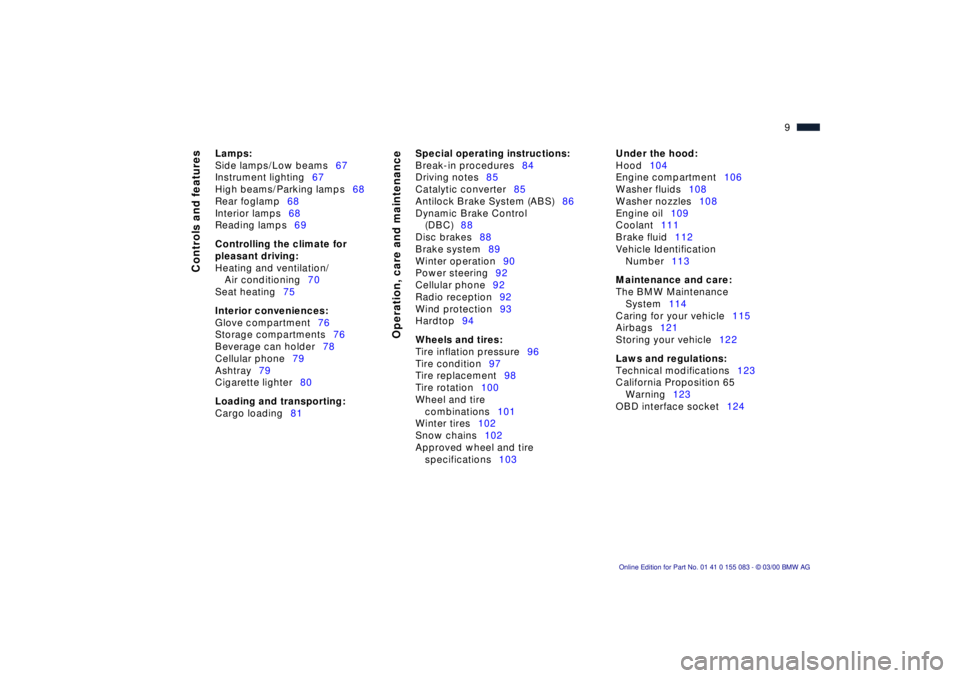
9n
Controls and features
Operation, care and maintenance
Lamps:
Side lamps/Low beams67
Instrument lighting67
High beams/Parking lamps68
Rear foglamp68
Interior lamps68
Reading lamps69
Controlling the climate for
pleasant driving:
Heating and ventilation/
Air conditioning70
Seat heating75
Interior conveniences:
Glove compartment76
Storage compartments76
Beverage can holder78
Cellular phone79
Ashtray79
Cigarette lighter80
Loading and transporting:
Cargo loading81
Special operating instructions:
Break-in procedures84
Driving notes85
Catalytic converter85
Antilock Brake System (ABS)86
Dynamic Brake Control
(DBC)88
Disc brakes88
Brake system89
Winter operation90
Power steering92
Cellular phone92
Radio reception92
Wind protection93
Hardtop94
Wheels and tires:
Tire inflation pressure96
Tire condition97
Tire replacement98
Tire rotation100
Wheel and tire
combinations101
Winter tires102
Snow chains102
Approved wheel and tire
specifications103
Under the hood:
Hood104
Engine compartment106
Washer fluids108
Washer nozzles108
Engine oil109
Coolant111
Brake fluid112
Vehicle Identification
Number113
Maintenance and care:
The BMW Maintenance
System114
Caring for your vehicle115
Airbags121
Storing your vehicle122
Laws and regulations:
Technical modifications123
California Proposition 65
Warning123
OBD interface socket124
Page 28 of 172
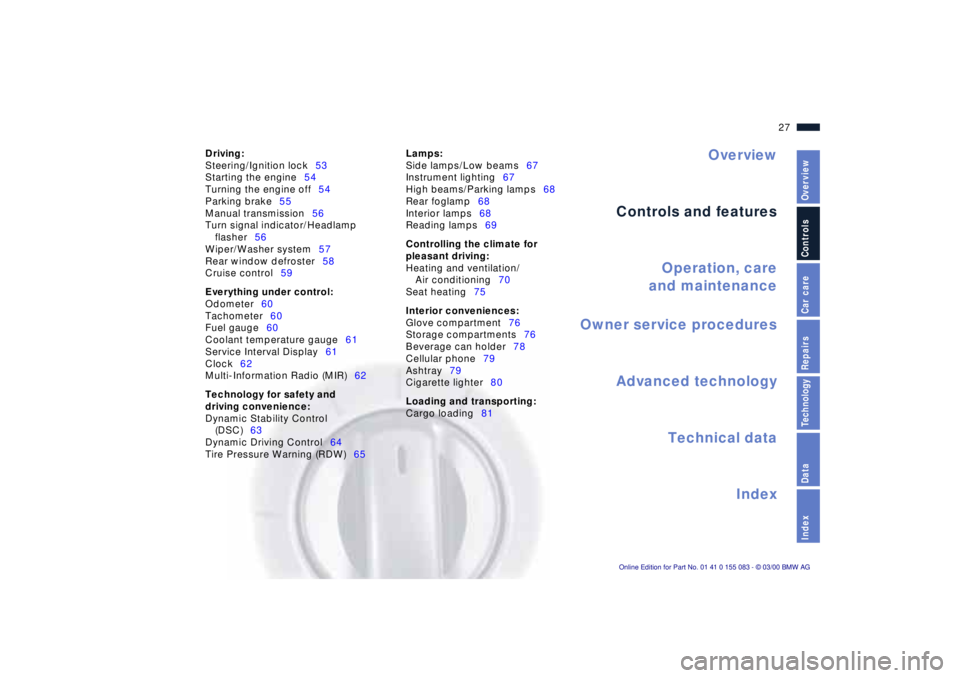
Overview
Controls and features
Operation, care
and maintenance
Owner service procedures
Technical data
Index Advanced technology
27n
IndexDataTechnologyRepairsCar careControlsOverview
Driving:
Steering/Ignition lock53
Starting the engine54
Turning the engine off54
Parking brake55
Manual transmission56
Turn signal indicator/Headlamp
flasher56
Wiper/Washer system57
Rear window defroster58
Cruise control59
Everything under control:
Odometer60
Tachometer60
Fuel gauge60
Coolant temperature gauge61
Service Interval Display61
Clock62
Multi-Information Radio (MIR)62
Technology for safety and
driving convenience:
Dynamic Stability Control
(DSC)63
Dynamic Driving Control64
Tire Pressure Warning (RDW)65Lamps:
Side lamps/Low beams67
Instrument lighting67
High beams/Parking lamps68
Rear foglamp68
Interior lamps68
Reading lamps69
Controlling the climate for
pleasant driving:
Heating and ventilation/
Air conditioning70
Seat heating75
Interior conveniences:
Glove compartment76
Storage compartments76
Beverage can holder78
Cellular phone79
Ashtray79
Cigarette lighter80
Loading and transporting:
Cargo loading81
Page 34 of 172

33n
IndexDataTechnologyRepairsCar careControlsOverview
Opening and closing Ð from outsideTo open the luggage
compartment lid Press button 3.
The luggage compartment lid will open
slightly.
Before and after a trip, be sure
that the luggage compartment lid
was not opened unintentionally.
the alarm system if there is an impend-
ing danger. The alarm system must be
armed in advance.
To switch off the alarm, press button 1.520de144
Local systems or devicesLocal systems or devices in the area
may interfere with remote control func-
tion. If this should occur, you can un-
lock and lock the vehicle via the door
lock with a master key.
For US owners onlyThe transmitter and receiver units com-
ply with Part 15 of the FCC (Federal
Communications Commission) regula-
tions. Operation is governed by the
following:
FCC ID: LX8EWS
LX8FZVS
LX8FZVE
Compliance statement:
This device complies with Part 15 of the
FCC Rules. Operation is subject to the
following two conditions:
>This device may not cause harmful
interference, and
>this device must accept any interfer-
ence received, including interference
that may cause undesired operation.
Any unauthorized modifications or
changes to these devices could
void the user's authority to operate this
equipment.<
Page 62 of 172

61n
IndexDataTechnologyRepairsCar careControlsOverview
Coolant temperature gauge Service Interval Display BlueThe engine is still cold. Drive at moder-
ate engine and vehicle speeds.RedWhen you switch on the ignition, the
warning lamp comes on briefly to con-
firm that the system is operational.
If the lamp comes on while operating
the vehicle, the engine has overheated.
Turn it off immediately and let it cool
down.520de031
Between the blue and red zonesNormal operating range. It is not un-
usual for the needle to rise as far as
the edge of the red zone in response
to high outside temperatures or severe
operating conditions.
For checking coolant level, refer to
page 111.
Remaining distance before
serviceThe displays shown in the illustration
appear for a few seconds when the
ignition key is in position 1 or after the
engine is started.
The remaining distance in miles before
the next scheduled service will appear
together with the display OILSERVICE
or INSPECTION.
The computer bases its calculations for
the remaining distance on the preced-
ing driving conditions.
A flashing display and a "Ð" in front of
the number indicate that service is past
due by the number of miles displayed.
Please contact your BMW center for an
appointment.520us006
Page 64 of 172
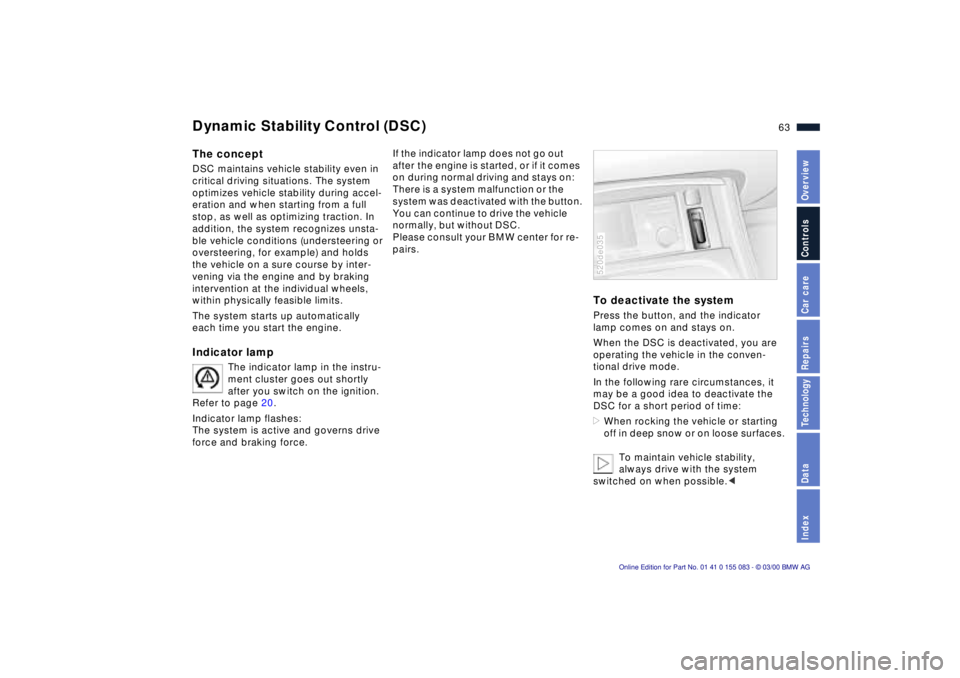
63n
IndexDataTechnologyRepairsCar careControlsOverview
The conceptDSC maintains vehicle stability even in
critical driving situations. The system
optimizes vehicle stability during accel-
eration and when starting from a full
stop, as well as optimizing traction. In
addition, the system recognizes unsta-
ble vehicle conditions (understeering or
oversteering, for example) and holds
the vehicle on a sure course by inter-
vening via the engine and by braking
intervention at the individual wheels,
within physically feasible limits.
The system starts up automatically
each time you start the engine.Indicator lamp
The indicator lamp in the instru-
ment cluster goes out shortly
after you switch on the ignition.
Refer to page 20.
Indicator lamp flashes:
The system is active and governs drive
force and braking force.
If the indicator lamp does not go out
after the engine is started, or if it comes
on during normal driving and stays on:
There is a system malfunction or the
system was deactivated with the button.
You can continue to drive the vehicle
normally, but without DSC.
Please consult your BMW center for re-
pairs.
To deactivate the systemPress the button, and the indicator
lamp comes on and stays on.
When the DSC is deactivated, you are
operating the vehicle in the conven-
tional drive mode.
In the following rare circumstances, it
may be a good idea to deactivate the
DSC for a short period of time:
>When rocking the vehicle or starting
off in deep snow or on loose surfaces.
To maintain vehicle stability,
always drive with the system
switched on when possible.<520de035
Dynamic Stability Control (DSC)
Page 66 of 172

65n
IndexDataTechnologyRepairsCar careControlsOverview
Tire Pressure Warning (RDW)The conceptThe RDW monitors the tire pressure in
all four wheels while driving. The sys-
tem provides an alert whenever the in-
flation pressure drops significantly in
one of the tires.
For RDW to "learn" the correct tire infla-
tion pressure, check the inflation pres-
sure in all tires, comparing them with
the values in the inflation pressure table
(refer to page 25), and make correc-
tions as necessary. Then activate the
system.
This indicator lamp in the instru-
ment cluster will flash to inform
you if the inflation pressure in
one of the tires has dropped signifi-
cantly.
To activate the system 1 Turn the ignition key to position 2
2 Press the switch long enough for the
indicator lamp in the instrument clus-
ter to light up red for a few seconds
3 The RDW undergoes an automatic
"learning" process while you are driv-
ing, and stores this data to aim for op-
timal conditions. This one-time "learn-
ing" process lasts at least 10 minutes,
after which the RDW is able to detect
and report any tire failure.
Repeat this process after any changes
in tire inflation pressure, tire rotation or
replacement.
Once the pressures have been adjusted
to the reference values used in the
"learning" process, do not activate the
system a further time.520de117
Tire failureThe red indicator lamp will flash in the
event of a tire failure.
A supplementary gong is also heard.
Carefully reduce speed to less than
50 mph (80 km/h), avoiding any hard
braking or steering maneuvers while
doing so.
For additional details, refer to page 135.
The RDW cannot alert you to
severe and sudden tire damage
caused by external factors.
Nor can it detect the gradual loss of
pressure at all four tires that normally
occurs over a period of time.<
Page 71 of 172
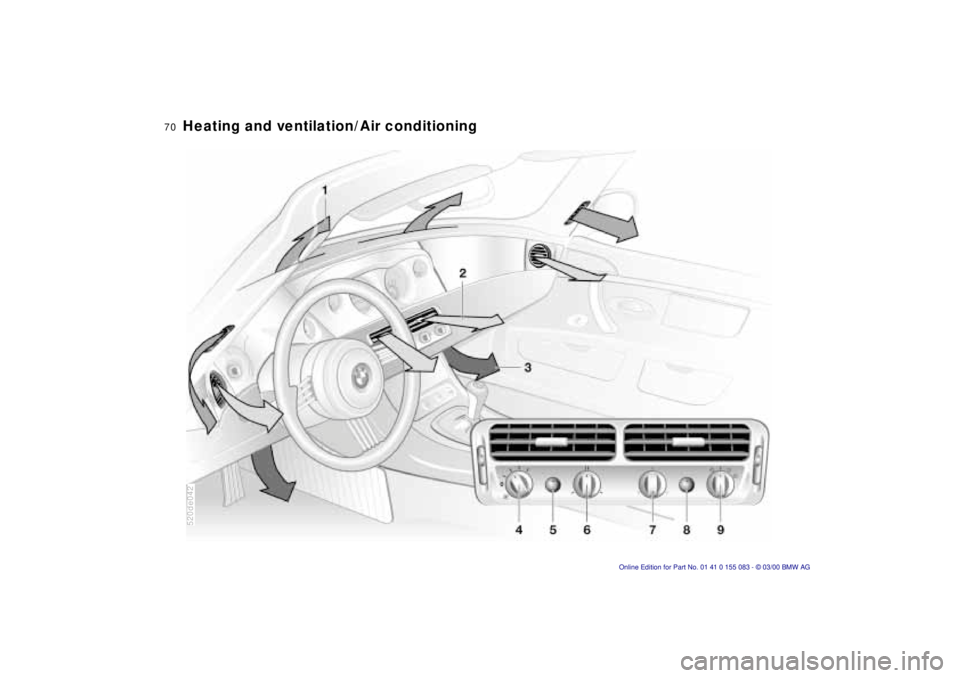
70n
520de042Heating and ventilation/Air conditioning
Page 72 of 172

71n
IndexDataTechnologyRepairsCar careControlsOverview
Heating and ventilation/Air conditioning1 Air onto the windshield and the side
windows
2 Air flow for the upper body
The rotary dials make it possible for
you to open and close the air supply
through an infinitely-variable range,
while the levers change the air-flow
direction. Refer to page 73
3 Front footwell ventilation
4 Air supply
Both the heating and ventilation are
available from position 1 on. Refer to
page 72
5 To defrost windows and remove
condensation73
6 Temperature72
7 Air distribution toward
>the windows
>the upper body
>the footwell
All intermediate settings are possible,
too. Refer to page 72
8 Rear window defroster with the
hardtop in place73
9 Operating
>Recirculated air72
>Incoming air72
>Air conditioner/Incoming air72
>Air conditioner/Recirculated air72
Page 73 of 172

72n
Heating and ventilation/Air conditioningAir supply
You can select blower speeds
from 1 to 4. The higher the set-
ting, the greater the amount of
heat and air supply. In position
0, the blower, heating and air condi-
tioner are switched off.
Temperature
In order to increase the inte-
rior temperature, turn to the
right. For rapid heating, turn
completely to the right. Then
select an interior temperature that is
comfortable for you.
Air distribution
You can direct the airflow onto
the windows , toward the
upper body and into the
footwell . You can also make
all intermediate settings. The "6 o'clock"
setting is recommended for normal con-
ditions (refer also to the illustration and
overview on page 70).
Recirculated air mode
If there are unpleasant odors
in the outside air, you can tem-
porarily block the air supply.
The system then recirculates
the air currently within the vehicle.
If the windows fog over when
using recirculated air, turn off the
recirculated air mode and increase the
airflow if necessary, or press the button
for "defrosting and defogging the win-
dows."<
Venting in outside air
Recommended when driving
with the convertible top open.
The degree to which the pas-
senger compartment is
heated depends on temperature selec-
tion and air distribution.
Air conditioner/Venting in outside
air
The air is cooled and dehu-
midified and Ð depending on
the temperature setting Ð
warmed again when the air
conditioner system is switched on.
Depending on the weather, the wind-
shield may fog over briefly when the
engine is started.
Do not turn on the air conditioner if out-
side air temperature is below approx.
41 7 (5 6). This will help to prevent
the windows from fogging.
If the windows fog over after switching
the air conditioner off, switch it back on.
Air conditioner/Recirculated air
mode
Both systems are operating.
Another advantage is that a
hot vehicle cools down more
quickly with the convertible
top closed. This way, you will get the
lowest possible vented air temperature
(turn the temperature rotary dial all the
way to the left).
Page 74 of 172
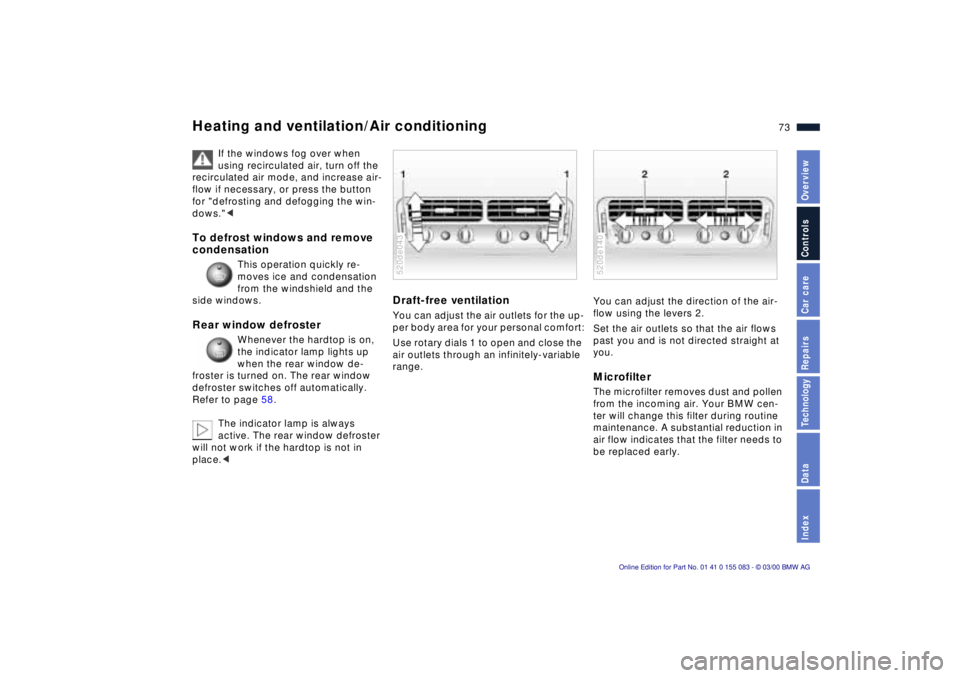
73n
IndexDataTechnologyRepairsCar careControlsOverview
Heating and ventilation/Air conditioning
If the windows fog over when
using recirculated air, turn off the
recirculated air mode, and increase air-
flow if necessary, or press the button
for "defrosting and defogging the win-
dows."<
To defrost windows and remove
condensation
This operation quickly re-
moves ice and condensation
from the windshield and the
side windows.
Rear window defroster
Whenever the hardtop is on,
the indicator lamp lights up
when the rear window de-
froster is turned on. The rear window
defroster switches off automatically.
Refer to page 58.
The indicator lamp is always
active. The rear window defroster
will not work if the hardtop is not in
place.<
Draft-free ventilation You can adjust the air outlets for the up-
per body area for your personal comfort:
Use rotary dials 1 to open and close the
air outlets through an infinitely-variable
range.520de043
You can adjust the direction of the air-
flow using the levers 2.
Set the air outlets so that the air flows
past you and is not directed straight at
you.MicrofilterThe microfilter removes dust and pollen
from the incoming air. Your BMW cen-
ter will change this filter during routine
maintenance. A substantial reduction in
air flow indicates that the filter needs to
be replaced early.520de140